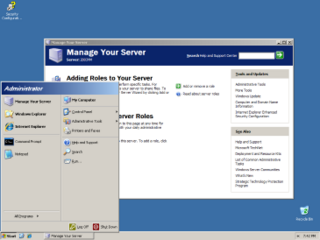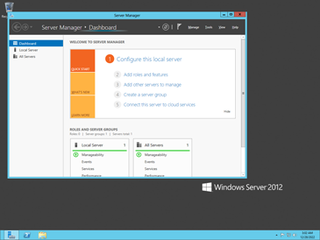Active Directory (AD) is a directory service developed by Microsoft for Windows domain networks. Windows Server operating systems include it as a set of processes and services. Originally, only centralized domain management used Active Directory. However, it ultimately became an umbrella title for various directory-based identity-related services.

Windows Server 2003, codenamed "Whistler Server", is the sixth major version of the Windows NT operating system produced by Microsoft and the first server version to be released under the Windows Server brand name. It is part of the Windows NT family of operating systems and was released to manufacturing on March 28, 2003 and generally available on April 24, 2003. Windows Server 2003 is the successor to the Server editions of Windows 2000 and the predecessor to Windows Server 2008. An updated version, Windows Server 2003 R2, was released to manufacturing on December 6, 2005. Windows Server 2003 is based on Windows XP.

Microsoft Defender Antivirus is an antivirus software component of Microsoft Windows. It was first released as a downloadable free anti-spyware program for Windows XP and was shipped with Windows Vista and Windows 7. It has evolved into a full antivirus program, replacing Microsoft Security Essentials in Windows 8 or later versions.

Shadow Copy is a technology included in Microsoft Windows that can create backup copies or snapshots of computer files or volumes, even when they are in use. It is implemented as a Windows service called the Volume Shadow Copy service. A software VSS provider service is also included as part of Windows to be used by Windows applications. Shadow Copy technology requires either the Windows NTFS or ReFS filesystems in order to create and store shadow copies. Shadow Copies can be created on local and external volumes by any Windows component that uses this technology, such as when creating a scheduled Windows Backup or automatic System Restore point.
Microsoft Servers is a discontinued brand that encompasses Microsoft software products for server computers. This includes the Windows Server editions of the Microsoft Windows operating system, as well as products targeted at the wider business market. Microsoft has since replaced this brand with Microsoft Azure, Microsoft 365 and Windows 365.

Windows Server 2008, codenamed "Longhorn Server", is the seventh major version of the Windows NT operating system produced by Microsoft to be released under the Windows Server brand name. It was released to manufacturing on February 4, 2008, and generally to retail on February 27, 2008. Derived from Windows Vista, Windows Server 2008 is the successor to Windows Server 2003 R2 and the predecessor to Windows Server 2008 R2. It removed support for processors without ACPI, and is the first version that includes Hyper-V.
Veritas Backup Exec is a data protection software product designed for customers with mixed physical and virtual environments, and who are moving to public cloud services. Supported platforms include VMware and Hyper-V virtualization, Windows and Linux operating systems, Amazon S3, Microsoft Azure and Google Cloud Storage, among others. All management and configuration operations are performed with a single user interface. Backup Exec also provides integrated deduplication, replication, and disaster recovery capabilities and helps to manage multiple backup servers or multi-drive tape loaders.
Microsoft SQL Server Express is a version of Microsoft's SQL Server relational database management system that is free to download, distribute and use. It comprises a database specifically targeted for embedded and smaller-scale applications. The product traces its roots to the Microsoft Database Engine (MSDE) product, which was shipped with SQL Server 2000. The "Express" branding has been used since the release of SQL Server 2005.

Quick Assist is a Microsoft Windows feature that allows a user to view or control a remote Windows computer over a network or the Internet to resolve issues without directly touching the unit. It is based on the Remote Desktop Protocol (RDP). It is complemented by Get Help, a feature introduced in Windows 10 that enables the user to contact Microsoft directly but does not allow for remote desktoping or screen sharing.
System Center Virtual Machine Manager (SCVMM) forms part of Microsoft's System Center line of virtual machine management and reporting tools, alongside previously established tools such as System Center Operations Manager and System Center Configuration Manager. SCVMM is designed for management of large numbers of Virtual Servers based on Microsoft Virtual Server and Hyper-V, and was released for enterprise customers in October 2007. A standalone version for small and medium business customers is available.

Hyper-V is a native hypervisor developed by Microsoft; it can create virtual machines on x86-64 systems running Windows. It is included in Pro and Enterprise editions of Windows NT as an optional feature to be manually enabled. A server computer running Hyper-V can be configured to expose individual virtual machines to one or more networks.

Visual Studio is an integrated development environment (IDE) developed by Microsoft. It is used to develop computer programs including websites, web apps, web services and mobile apps. Visual Studio uses Microsoft software development platforms including Windows API, Windows Forms, Windows Presentation Foundation (WPF), Microsoft Store and Microsoft Silverlight. It can produce both native code and managed code.
Microsoft SQL Server is a proprietary relational database management system developed by Microsoft. As a database server, it is a software product with the primary function of storing and retrieving data as requested by other software applications—which may run either on the same computer or on another computer across a network. Microsoft markets at least a dozen different editions of Microsoft SQL Server, aimed at different audiences and for workloads ranging from small single-machine applications to large Internet-facing applications with many concurrent users.

Windows Server 2008 R2, codenamed "Windows Server 7", is the eighth major version of the Windows NT operating system produced by Microsoft to be released under the Windows Server brand name. It was released to manufacturing on July 22, 2009, and became generally available on October 22, 2009, the same respective release dates of Windows 7. It is the successor to Windows Server 2008, which is derived from the Windows Vista codebase, released the previous year, and was succeeded by the Windows 8-based Windows Server 2012.

Windows Server 2012, codenamed "Windows Server 8", is the ninth major version of the Windows NT operating system produced by Microsoft to be released under the Windows Server brand name. It is the server version of Windows based on Windows 8 and succeeds Windows Server 2008 R2, which is derived from the Windows 7 codebase, released nearly three years earlier. Two pre-release versions, a developer preview and a beta version, were released during development. The software was officially launched on September 4, 2012, which was the month before the release of Windows 8. It was succeeded by Windows Server 2012 R2 in 2013. Mainstream support for Windows Server 2012 ended on October 9, 2018, and extended support ended on October 10, 2023. Windows Server 2012 is eligible for the paid Extended Security Updates (ESU) program, which offers continued security updates until October 13, 2026.
Server Core is a minimalistic Microsoft Windows Server installation option, debuted in Windows Server 2008. Server Core provides a server environment with functionality scaled back to core server features, and because of limited features, it has reduced servicing and management requirements, attack surface, disk and memory usage. Andrew Mason, a program manager on the Windows Server team, noted that a primary motivation for producing a Server Core variant of Windows Server 2008 was to reduce the attack surface of the operating system, and that about 70% of the security vulnerabilities in Microsoft Windows from the prior five years would not have affected Server Core. Most notably, no Windows Explorer shell is installed. All configuration and maintenance is done entirely through command-line interface windows, or by connecting to the machine remotely using Microsoft Management Console (MMC), remote server administration tools, and PowerShell.

Windows Server 2012 R2, codenamed "Windows Server Blue", is the tenth major version of the Windows NT operating system produced by Microsoft to be released under the Windows Server brand name. It was unveiled on June 3, 2013, at TechEd North America, and released on October 18 of the same year. It is the successor to Windows Server 2012, and is based on the Windows 8.1 codebase. Windows Server 2012 R2 is the final version of Windows Server to use the "R2" suffix, which had been used since the release of Windows Server 2003 R2 in 2005.

Windows Server 2016 is the eleventh major version of the Windows NT operating system produced by Microsoft to be released under the Windows Server brand name. It was developed alongside Windows 10 and is the successor to the Windows 8.1-based Windows Server 2012 R2. The first early preview version became available on October 1, 2014 together with the first technical preview of System Center. Windows Server 2016 was released on September 26, 2016 at Microsoft's Ignite conference and reached general availability on October 12, 2016.

Windows Subsystem for Linux (WSL) is a feature of Microsoft Windows that allows for using a Linux environment without the need for a separate virtual machine or dual booting. WSL is installed by default in Windows 11. In Windows 10, it can be installed either by joining the Windows Insider program or manually via Microsoft Store or Winget.

MSP360, formerly CloudBerry Lab, is a software and application service provider company that develops online backup, remote desktop and file management products integrated with more than 20 cloud storage providers.












